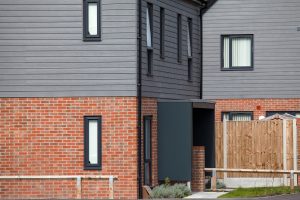
Richard Haines, Director at Eurobrick, discusses some of the benefits of using brick slip cladding in local authority building projects.
For housing, a brick finish remains as popular as ever. Brick slip cladding offers an alternative to traditional brickwork and a number of benefits for local authority housing and affordable homes. Eurobrick Systems was the first company to introduce a comprehensively designed brick slip cladding system to the UK 27 years ago. Since then, it has supplied a wide range of projects, including residential, leisure, hospitals, schools, colleges and universities throughout the country.
The popularity of brick slip cladding has grown significantly over the years. It is now a sought after finish for large-scale projects for a number of reasons, not least the ease and speed of installation. The ongoing housing crisis has put a sharp focus on the urgent need to quickly build large numbers of good quality homes. Traditional construction appears to remain the go-to method but this is a slow process and is being increasingly augmented by modern building techniques including a resurgence of interest in offsite built modular homes.
Brick slip cladding is suitable for both on and offsite installation and it is this type of versatility that is beneficial to housing projects. These systems can help to speed up onsite operations and in an environment where delays can be costly, any delivery saving is significant.

This form of cladding is ideal for offsite built modular homes. The systems are usually lightweight compared to traditional brickwork. In a controlled factory environment, an experienced installer should be able to fit at least 1m² per hour. Brick cladding only requires semi-skilled labour to install too, reducing dependency on traditional skilled workers.
A good quality system is also robust enough to withstand the stresses of being lifted, transported to site on the back of a lorry, and craned into position. A modular building that can be delivered to site and does not require substantial finishing works to the exterior is a major advantage for housing providers.
External façade
The wide range of brick slips now available will allow specifiers to match the finish of existing structures, or even to over-clad extensions and original properties to create a seamless finish, with the option of added insulation benefits. For a more modern finish, brick slip cladding systems are flexible and can be used in conjunction with other cladding systems (such as timber and render).
If cold or damp is an issue, layers of insulation can be added to the cladding system to improve thermal performance and the slim profile means the overall thickness of walls is reduced. Where there is restricted space at ground level, building upwards is also achievable with brick slip cladding, which is generally lightweight and does not require the foundations associated with traditional masonry. This helps to simplify the design, thereby reducing costs. Cladding can also be fitted to many different substrates and some systems are certified for use on high-rise buildings.
Low maintenance
Brick slip cladding is durable too. Kiln-fired clay brick slips weather and age in the same way as conventional brickwork and a brick slip exterior will require little to no maintenance. It is important to note that the life span of different cladding systems may vary, so this should be checked with the suppliers. It should also be noted that not all available brick slip systems have been through an independent rigorous testing and certification process. Confirmation of certification from the cladding supplier should always be requested.
“In a controlled factory environment, an experienced installer should be able to fit at least 1m² per hour.”
There are many advantages to brick slip cladding. Most notably for local authorities is the speed of delivery and the aesthetic advantage of achieving a real brick finish, whether it is a new-build development or as part of a refurbishment project.
Belle Vale
Eurobrick’s BBA certified P-Clad system was used recently on a residential project in Liverpool. Belle Vale was a new £3.5m development of 33 eco homes constructed for Liverpool Mutual Homes. The contractor adopted modern construction techniques to build modular houses for the project, which were constructed offsite in a factory before being transported to site in sections.
The system was installed offsite, which offers benefits in terms of quality control and speed of project delivery. The development has a contemporary mixed finish and Eurobrick supplied circa 1,600m² of P-Clad along with Autumn Leaves brick slips and Smooth Red slips for the plinth detail. The ground floor of the houses was finished entirely with P-Clad with a brick slip panel detail to the first floors. The brickwork was pointed using standard grey pointing mortar.








